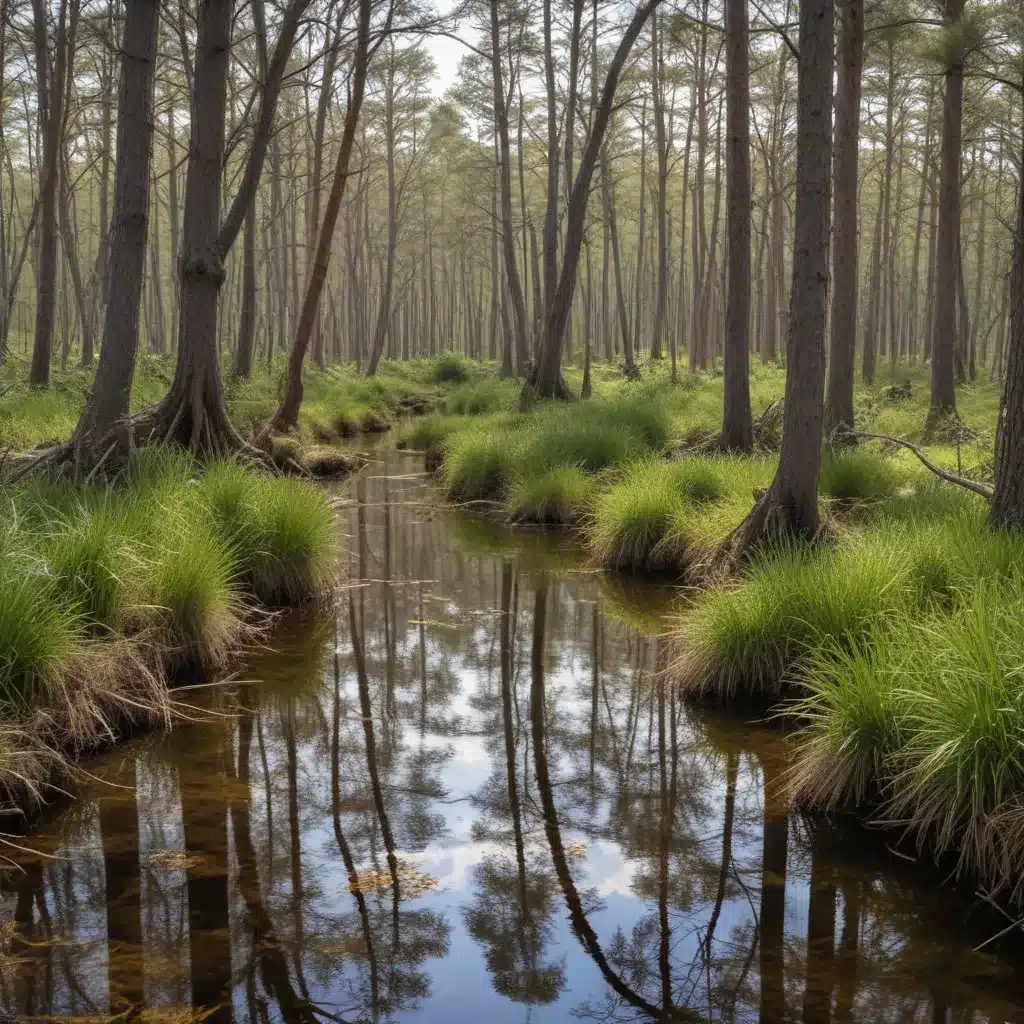
From the lush, verdant meadows to the dense, towering forests, Crooked Pines Farm is a true nature lover’s paradise. Yet, nestled within this vibrant landscape lie some of the farm’s most enchanting and ecologically vital environments – its wetland habitats. These aquatic oases are teeming with diverse life and play a crucial role in maintaining the delicate balance of our local ecosystem.
Wetland Ecosystem Characteristics
Hydrology and Water Dynamics
The lifeblood of any wetland is its water. At Crooked Pines, our wetlands are fed by a complex network of springs, seeps, and streams that ebb and flow with the seasons. During the wet spring months, these waters swell, inundating the surrounding low-lying areas and creating vast seasonal ponds and marshes. As summer approaches and rainfall diminishes, the water table gradually recedes, revealing a tapestry of mucky soils, standing water, and saturated substrates. This dynamic interplay between aquatic and terrestrial conditions is what defines the unique character of a wetland.
Vegetation and Flora
The plant life that thrives in these damp environments is nothing short of captivating. Cattails, water lilies, and bulrushes carpet the shallows, their lush foliage and vibrant blooms providing vital habitat and food resources for a host of wetland creatures. Along the fringes, you’ll find a diverse array of sedges, rushes, and herbaceous wildflowers that help to stabilize the soil and filter runoff. And in the deeper waters, pondweeds, duckweed, and submerged aquatic vegetation form the foundation of the aquatic food web.
Wildlife and Fauna
Crooked Pines’ wetlands are true hubs of biodiversity, supporting a magnificent array of wildlife. Waterfowl, such as ducks, geese, and herons, are a common sight, gracefully gliding across the still waters or wading in search of aquatic prey. Secretive amphibians, like frogs and salamanders, breed and thrive in the shallow pools, while mammals like muskrats, beavers, and otters leave their telltale signs along the muddy banks. Even insects, from dragonflies to pollinators, find vital resources and habitat in these lush, water-blessed environments.
Biodiversity Exploration
Rare and Endangered Species
Crooked Pines’ wetlands are home to several rare and endangered species that rely on these delicate habitats for their survival. One such species is the spotted turtle, a small, charismatic reptile that has been listed as a species of special concern due to habitat loss and fragmentation. By exploring our wetland trails, you may be lucky enough to catch a glimpse of this elusive creature basking on a fallen log or cautiously swimming through the shallows.
Indicator Species
Certain species found in our wetlands can serve as valuable indicator species, providing insights into the overall health and ecological integrity of these environments. The presence of sensitive macroinvertebrates, like caddisflies and mayflies, for example, often signifies high water quality and a thriving food web. Monitoring the populations of these species can help us track the wellbeing of our wetland ecosystems over time.
Habitat Complexity
Wetlands are inherently complex systems, with a mosaic of microhabitats that support a wide range of organisms. From the floating vegetation mats that provide shelter and nesting sites to the intricate network of submerged logs and fallen branches that harbor diverse communities of aquatic life, each component plays a vital role in sustaining the overall biodiversity of these remarkable places.
Ecological Functions and Services
Flood Mitigation
Wetlands are nature’s sponges, absorbing and slowly releasing excess water during periods of heavy precipitation or snowmelt. By acting as natural flood control mechanisms, our wetland habitats help to prevent downstream flooding and protect surrounding farmland, homes, and infrastructure from the devastating impacts of extreme weather events.
Water Purification
The dense vegetation and slow-moving waters of our wetlands act as natural water filtration systems, trapping sediments, nutrients, and other pollutants before they can reach our streams, rivers, and groundwater supplies. This invaluable ecosystem service helps to maintain the high quality of the water resources that sustain both our farm and the surrounding community.
Carbon Sequestration
Wetlands are also incredibly efficient at carbon sequestration, the process of capturing and storing atmospheric carbon dioxide. The lush, productive plant growth in our wetlands – combined with the deep, organic-rich soils – make them remarkable natural carbon sinks, helping to mitigate the effects of climate change by removing greenhouse gases from the atmosphere.
Conservation Efforts
Wetland Preservation
At Crooked Pines Farm, we are deeply committed to the preservation and stewardship of our wetland habitats. Through sustainable management practices, such as carefully monitoring water levels, controlling invasive species, and protecting sensitive areas, we work tirelessly to ensure the long-term health and viability of these irreplaceable ecosystems.
Restoration Initiatives
In addition to preserving our existing wetlands, we also engage in restoration projects to rehabilitate degraded or impacted areas. By reintroducing native plants, improving water flow, and enhancing habitat complexity, we are able to breathe new life into these vital ecosystems, restoring their ecological functions and providing safe haven for a wide array of plants and animals.
Community Engagement
Engaging our local community is a core part of our mission at Crooked Pines Farm. By offering educational nature walks, hands-on wetland learning experiences for children, and citizen science opportunities, we empower visitors to become active stewards of these precious habitats. Together, we can foster a greater appreciation for the importance of wetlands and the vital role they play in sustaining the health and vitality of our entire region.
So, the next time you visit Crooked Pines Farm, be sure to explore the captivating world of our wetland habitats. From the vibrant, burgeoning life that teems within their waters to the essential ecosystem services they provide, these hidden gems are truly the heart and soul of our farm’s natural landscape. Join us in celebrating and preserving these remarkable places for generations to come.


